Endurance performance has so far been made up of maximising VO₂ max and functional capacity. Movement economy is the second last physiological determinant of endurance performance before moving into external and nutritional influences. Movement economy refers to the efficiency at which somebody moves from one point to another. An individual with efficient movement economy can travel at speed using less energy (oxygen) than their inefficient counterparts. Movement economy is largely influenced by force summation as a result of an individual’s technique. The following is a simplified model which will discuss the key determinants of efficient running gait. There are many factors to consider, but we will explore the major components which will bring about a more efficient technique.
Ideal running technique versus a poor technique. Source: http://www.lvsportsperformance.com/strength/not-born-to-run/
1. Balanced Forward Posture
Good runners are dead straight in their posture from head to toe, accompanied with a slight forward lean initiated from the ankles. This drastically reduces your energy consumption. Why? Your centre of mass is moved towards the edge of your base of support, reducing your body's resistance to forward movement. In the picture on the left, the runner's centre of mass (yellow dot on his chest) is behind his base of support (yellow heel strike dot in his foot). In order for him to propel into forward motion, the centre of mass must be moved in front of, or directly underneath, the base of support. Every action has an equal and opposite reaction. In this first picture, the runner is actually creating a braking force initially (slowing down), until the base of support (ie foot strike) is moved directly underneath the centre of mass. Note that with the picture on the right, the runner's centre of mass is already directly under his base of support, so he is able to produce propulsive force immediately with no wasted energy in trying to correct his unbalanced posture.
2. Compact Arms
The ideal arm position is with the elbows at 90⁰, the wrist passing just above the hip, a full arm drive backwards, and a partial recovery with the wrist not moving far forward of the hip. Arm position assists with cadence, proper foot strike, balance and energy efficiency. The body moves in a sequential pattern: you will find it difficult to coordinate it without properly using your arms. Try this: Move your arms more quickly as you run. What do you find? Your cadence (steps per minute) will naturally increase too. Try to relax your shoulders as much as possible while you run, as tense upper body muscles is just wasted energy which isn't helping to propel you forward.
3. Proper Foot Strike
Foot strike refers to the section of the foot which contains the centre of pressure (ie the section of the foot you land on) - this can be a rear (heel) foot strike, mid-foot strike, or a forefoot (toes) strike. There is still much debate in the research as to which foot strike is the most economical style. A heel striker will place more strain on their knees, whereas a forefoot striker places more strain on their calf and achilles. The type of foot strike isn't necessarily important, it is where the foot lands in relation to your centre of mass, as described above, which is crucial. ANY foot strike which occurs in front of the centre of mass creates a braking force, which is guaranteed to slow you down every step. The challenge is to consistently get your foot landing directly underneath your centre of mass so that all of your energy is devoted to creating forward speed. How is this achieved? Increase your cadence...
4. High Cadence
Most research agrees that a cadence of 180 steps/minute is generally a good goal to aim for. This high cadence is achieved through reducing stride length and quickening your turnover rate. This combination naturally avoids over-striding which is associated with a foot plant in front of your centre of mass. Improving cadence allows us to consistently land underneath our centre of mass, thereby avoiding braking forces, and devoting all of our energy into creating propulsive forces which maintain/increase our speed using the minimum amount of energy.
Summary of an ideal running technique. Source: http://blog.bsxathletics.com/2013/03/27/recommendations-for-great-running-form
Summary
Changes in any of the above determinants have a direct and immediate effect on all the other determinants. My recommendation is to determine your current running cadence (many sport/GPS watches measure this), and gradually increase this to around 180 steps/minute over time. This can be achieved through taking smaller strides, swinging your arms more quickly, and focusing on creating a slight forward lean at the ankles (while maintaining an upright posture). You will be surprised with the immediate improvements in foot strike and forward posture created simply through upping your cadence. You will become a more economical runner and will use less energy than in the past at all running speeds.
Feel free to follow us on our socials:
Facebook: METS Performance Consulting
Instagram: @metsperformance
Twitter: @METSperfconsult
Written by Luke McIlroy – Director of Sport Science at METS Performance Consulting
BEx&SpSci, ESSAM, AES

![GuyRunning[Edited].jpg](https://images.squarespace-cdn.com/content/v1/589286b53e00be6ae883e566/1486629968634-INHXM4SCSA6GIVFUJFTH/GuyRunning%5BEdited%5D.jpg)

